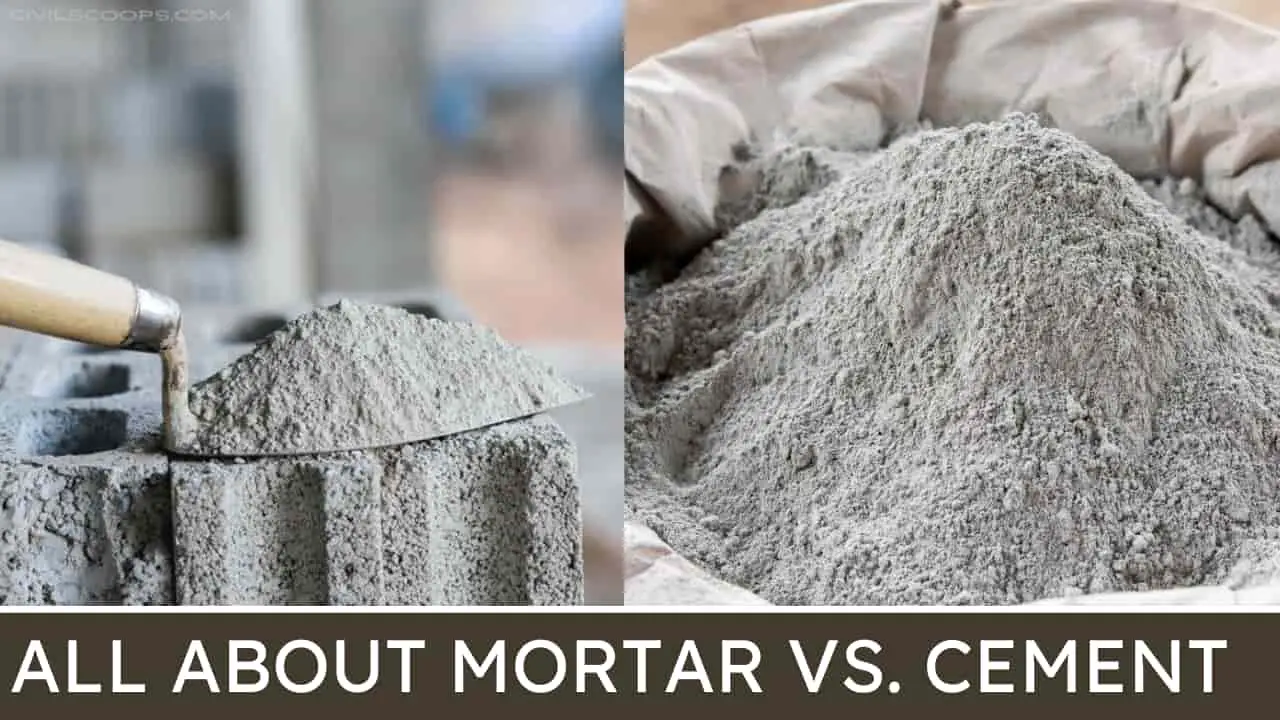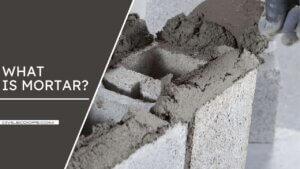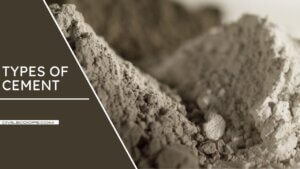Mortar Vs Cement | Types of Cement | Types of Mortar

Table of Contents
Mortar Vs. Cement
The difference between mortar and cement is that cement is the bonding agent, while the mortar is a product composed of cement, sand, and lime.
Both substances have different purposes, as the cement is activated with water and forms a connection with other elements to form a solid object, while the mortar is useful to keep bricks or stones together and cannot be alone like concrete.
Cement is a substance used to make mortar and concrete etc.
There are different types of uses for each mortar, mortar, or concrete mixed with cement, as the mortar can fill in gaps between the tiles, but if the joints of the blocks are missing pieces, you will need mortar.
What Is Mortar?

The mortar contains bonding enhancers used to fill the spaces between blocks of stone, brick, or concrete during construction. It is also used for repair and renovation purposes.
The mortar is applied as a thick paste and hardens after a short period of time to create a firm seal between stones or bricks to prevent air and moisture from entering the structure.
Mortar has the ability to bond with joint reinforcements, etc., on bricks. It helps to create an aesthetically pleasing and structurally solid building.
The first man-made mortar construction was made of clay and clay, in addition to the ancient Egyptians who used limestone bricks.
Mortar is commonly used today and available in different types, like Portland mortar, made with Portland cement, sand, and water. Another type is called lime mortar, which allows moisture to move freely and
Evaporate from the surface. Mortar has a long service life without the need for constant repairs.
Types of Mortar

Mortar is produced by mixing a bonding material (cement or lime) with fine aggregate (sand, surki, etc.) with water.
For construction purposes, different types of mortar are used. Depending on the materials used in the preparation of the mortar mix, the mortar can be classified as follows.
- Cement mortar
- Lime mortar
- Surki Mortar
- Gauged mortar
- Mud Mortar
1. Cement Mortar
Cement mortar is a types of mortar where cement is used as a bonding material, and sand is used as a fine aggregate. Depending on the desired strength, the ratio of cement to cement mortar sand varies from 1: 2 to 1:6.
2. Lime Mortar
Lime mortar is a types of mortar in which lime (fatty lime or hydraulic lime) is used as a bonding material, and sand is used as fine aggregate. The lime/sand ratio of the cement mortar is maintained at 1: 2.
The pyramids of Giza are covered with lemon mortar.
3. Gauged Mortar
Gauged mortar is a types of mortar where cement and lime are used as a bonding material, and sand is used as fine aggregate. Basically, it is a lime mortar where cement is added for greater strength.
The process is known as gauging. The ratio of cement to lime varies from 1: 6 to 1: 9. The calibrated mortar is economical than cement concrete and also has greater strength than lime mortar.
4. Surki Mortar
Surki mortar is a types of mortar in which lime is used as a bonding material, and surki is used as a fine aggregate. Surki mortar is economical.
5. Mud Mortar
Mud mortar is a types of mortar where mud is used as a bonding material, and sawdust, rice husk, or cow dung are used as fine aggregate. Mud mortar is useful when there is no lime or cement.
Summary
- Cement is a binding agent to form mortar, concrete, and mortar.
- Mortar is made by adding water, sand, and lime to the cement.
- Mortar is commonly used to fill in the gaps between bricks and stones to prevent moisture from seeping out.
- Cement has many types, such as Portland, masonry cement, etc.
- Mortar has many types and colors, such as terracotta or white, etc.
What Is Cement?

Cement has many types, such as Portland, white cement, or masonry. Portland cement is used for structural applications to form an object.
The mortar, as it can contain Portland cement with lime or masonry cement, lime and sand, brings together masonry units in structural systems.
The mixing ratio of the cement and the other ingredients determines the resistance to compression and adhesion, including the absorption potential.
Types of Cement

The following are the types of cement:
- Ordinary Portland Cement (OPC)
- Portland Pozzolana Cement (PPC)
- Rapid-Hardening cement
- Low heat cement
- White cement
- Hydrophobic cement, etc.
1. Ordinary Portland Cement (OPC)
In normal construction work, common Portland cement is widely used. The composition of common Portland cement:
- Alumina clays or silicates (clay and shale)
- Calcareous or calcium carbonate (limestone, chalk, and marl)
Uses of common Portland cement
- It is used for general construction purposes.
- It is also used in most masonry works.
2. Portland Pozzolana Cement (PPC)
Pozzolans are natural or synthetic materials that contain silica in reactive forms. It reacts with the calcium hydroxide generated by hydrating the cement to form additional cementation materials when it is finely divided. The composition of Portland Pozzolana cement:
- OPC clinker
- Plaster
- Pozzolanic materials (fly ash, volcanic ash, and vapors of clay or calcined silica).
Uses of Portland Pozzolana cement
PPC is generally used in hydraulic structures, marine structures, construction near the coast, construction of dams, etc.
- It is also used in pre-stressed and post-stressed concrete elements.
- As it provides a better surface finish, it is used in decorative and artistic structures.
- It is also used in the manufacture of prefabricated sewer pipes.
3. Rapid-Hardening cement
When finely ground tri-calcium silicate (C3S) is present in the higher content OPC, it gains strength more Rapidly than OPC. This type of OPC is called Rapid-Hardening cement.
It is the initial setting time of 30 minutes and the final Hardening time of 600 minutes.
Uses of Rapid-Hardening cement
- Rapid-Hardening cement is used mainly where rapid construction is required, such as pavement construction.
- It also offers high strength.
4. Low heat cement
It is a spatial type of cement that produces low heat of hydration during the environment. Some chemical composition of ordinary Portland cement is modified to reduce the heat of hydration. The chemical composition of low heat cement:
- A low percentage (5%) of tricalcium aluminate (C3A)
- A higher percentage (46%) of decanted silicate (C2S).
Uses of low heat cement
- It is used for the construction of large dam feet, slabs of large rafts, and baseboards for wind turbines.
- It is also used for the construction of chemical plants.
5. White cement
White cement is quite similar to ordinary Portland cement, except for its color. Amounts of iron oxide and manganese oxide are low in white cement. It is expensive, so OPC is not economical for ordinary work.
Uses of white cement
- It is generally used in decorative works.
- It can also be used for traffic barriers, tile grout, swimming pools, tile patch materials, and terrace surfaces.
[su_box title=”FAQ” style=”default” box_color=”#333333″ title_color=”#FFFFFF” radius=”3″ class=”” id=””]
Mortar Vs. Cement
Cement is a fine binding powder that is never used alone but is a component of both concrete and mortar, as well as stucco, tile grout, and thin-set adhesive. Mortar is composed of cement, fine sands, and lime; it is used as a binding material when building with brick, block, and stone.
Mortar Vs Concrete
Basically concrete is stronger and more durable so it can be used for structural projects such as setting posts whereas mortar is used as a bonding agent for bricks, stones, etc. Concrete is a mixture of water, cement, sand just like mortar.
Type N Vs Type S Mortar
Type N mortar is a general-purpose mortar that provides good workability and serviceability. It is commonly used in interior walls, above-grade exterior walls under normal loading conditions, and in veneers. Type S mortar is used in structural load-bearing applications and for exterior applications at or below grade.
Masonry Cement Vs Mortar Cement
Masonry cement is mixed with sand and water to produce mortar for brick, block and stone construction. Mortar is the bonding agent that forms individual masonry units into a wall. Other applications include stucco and cement-based plasters.
Cement Vs Concrete Vs Mortar
The basic difference is that cement is a fine binding powder (which is never used alone), mortar is composed of cement and sand, and concrete is composed of cement, sand, and gravel.
[/su_box]
[su_note note_color=”#F2F2F2 ” text_color=”#333333″ radius=”3″ class=”” id=””]
- Types of Wood
- All About of Portland Cement Uses
- What Is Lintel? | Function of Lintel | Types of Lintel
- OPC vs PPC | Difference between OPC and PPC Cement
- What Is ACP | Applications of ACP Sheet | Advantage of ACP Sheet | Disadvantages of ACP Sheet
[/su_note]
Originally posted 2022-06-17 17:49:51.
